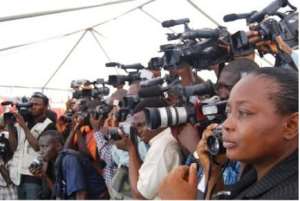
The Public Interest and Accountability Committee has launched its 5th report of the committee since its inauguration in September, 2011.
According to PIAC, petroleum revenue has been growing year by year since first oil in 2010; therefore there is the need to remain focused in ensuring prudent management.
Key findings and recommendations by PIAC includes utilization of the ABFA (Annual Budget Fund Amount) 2012 Annual Report, where the committee found that the Ministry of Finance did not provide enough information for the 2012 PIAC Annual Report. However, the Ministry of Finance has now provided the information which is analyzed and published in this report.
Again, there was a low yield on investment in the investment of the Ghana Petroleum Funds 2012. The Minister of Finance made proposals in the 2014 Budget to deal with this problem.
Similarly, on enactments of regulations, action on this exercise began in 2013 but is on hold pending amendment of the main Act. Two oilfields, Tweneboa-Enyera-Ntomme (TEN) and Sankofa-Gye-Nyame, will be added to Jubilee to boost oil production in 2016 and 2017 respectively. Two new discoveries were made by the GNPC in 2013 bringing the total number of discoveries made since Jubilee to 23.
The Ghana National Gas Company Limited continued with the implementation of the Western Corridor Gas Infrastructure Development Project. The project, which was expected to be completed during the 3rd quarter of 2013 and subsequently revised to December 2013, encountered a number of challenges that have delayed its completion.
Further findings includes the average achieved price for the jubilee crude oil for years 2013 of US$106.95 was higher than the forecast average price used in estimating benchmark revenue.
The total petroleum revenues in 2013 were US$846,767,184 converted to yield Ghc1, 645,585. This brings cumulative revenue received since 2011 to US$1.83 billion equivalent to Ghc3.291 billion.
Although there has been tremendous increase in petroleum revenue in 2013 and an increase in the Annual Budget Funding Amount (ABFA), a total US$726.7 million, however no provision was made for the media as part of capacity building which forms part of the four ABFA priority areas approved by parliament.
Ghc20.18 million representing 3.7 % was spent on capacity building with Gh¢2 million going to support the creative industry while another Gh¢8.1 million was given out as cash transfer under the LEAP.
GH¢35 million have been pumped into Masloc, while another Gh¢19 million has been used to set up Venture Capital Fund and Exim Guarantee Fund without any real allocation to the media.
One wonders why as the fourth estate of the realm that plays a watchdog and oversight role and a stakeholder in the oil and gas industry, will be left out in the petroleum revenue distribution.
How can the media function properly in this regard? In the year 2013, the ABFA was allocated to the four priority areas are roads and other infrastructure, GH¢372.07 million (68.4%), amortization of loans GHc137.92 (25.4%). , capacity building Ghc20.18 million (2.5%).
The road sector benefitted the most from the funds allocated from ABFA in 2013 but none of these projects was completed in the year.
PIAC says there was a discrepancy between the amount of money reported to have been transferred to Ghana National Gas Company during the year by the Ministry of Finance and what was reported as received by the company totaling about Ghc85.82 million.
It further stated that there was a need for government to endeavor to focus its expenditure under the capacity building priority area on interventions that will directly enhance the capacity and capabilities of Ghanaians to enable them participate fully in the oil industry as envisioned by the Local Content Policy and Regulations.




 Akufo-Addo spotted ordering chiefs to stand for his handshake
Akufo-Addo spotted ordering chiefs to stand for his handshake
 Akufo-Addo ‘disrespects’ every chief in Ghana except Okyenhene — NDC Communicato...
Akufo-Addo ‘disrespects’ every chief in Ghana except Okyenhene — NDC Communicato...
 Supreme Court clears way for dual citizens to hold key public positions
Supreme Court clears way for dual citizens to hold key public positions
 Be transparent, don’t suppress the truth – Prof. Opoku-Agyemang to Jean Mensa
Be transparent, don’t suppress the truth – Prof. Opoku-Agyemang to Jean Mensa
 ‘I won’t tell the world I was only a driver’s mate during challenges’ – Prof Jan...
‘I won’t tell the world I was only a driver’s mate during challenges’ – Prof Jan...
 We’ll prosecute corrupt officials of Akufo-Addo’s govt – Prof Jane Naana
We’ll prosecute corrupt officials of Akufo-Addo’s govt – Prof Jane Naana
 [Full text] Acceptance speech by Prof Jane Naana Opoku-Agyemang as 2024 NDC Runn...
[Full text] Acceptance speech by Prof Jane Naana Opoku-Agyemang as 2024 NDC Runn...
 Election 2024: Don’t be complacent, we haven’t won yet – Asiedu Nketia cautions ...
Election 2024: Don’t be complacent, we haven’t won yet – Asiedu Nketia cautions ...
 Election 2024: Stop fighting over positions in Mahama’s next govt – Asiedu Nketi...
Election 2024: Stop fighting over positions in Mahama’s next govt – Asiedu Nketi...
 Prof Jane Naana Opoku-Agyemang will restore dignity of vice presidency – Fifi Kw...
Prof Jane Naana Opoku-Agyemang will restore dignity of vice presidency – Fifi Kw...
